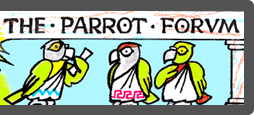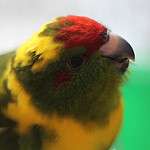First of all - so glad I found this forum, it seems to be busier than other bird-related ones, so I'm looking forward to sticking around and learning new things.
I have owned three budgies in the past - from 1992 to 1994 (died of a heart attack), in 1996 (somebody bought me a sick bird for my birthday) and 2003 to 2008 (died of cancer) and the first bird was exceptional. He never learned to talk, but he was a sweetheart, the sick bird was on her way to become like that. The third was not hand-reared and he bonded with my dad to a certain degree, but that was it. He was not attacking us, but when we'd come close, he would most definitely bite.
And after that...I just didn't own a bird for more than seven years. Got a small dog I rescued from the street in 2011, but some months ago, I thought about owning a bird again. Given my experience with budgies and how heartbreaking it was to see the last one die in my hands, regardless of what he was like to me, I thought about something bigger, but not too big. A friend advised me to save for a Cockatoo or an African grey, since I like my animals social and all, but I was concerned about noise. I thought about rozellas, but a friend who breeds birds for pet shops (I'm against his approach, but that's a whole different story) told me that I should get a kakariki instead, he also recommended a girl who hand-rears them, whose dad is a respected breeder. My reasoning was that this bird will be less likely to get sick than a budgie and friendlier than a rozella.
So, I picked a bird from photos the girl was posting, I went to pick him up. He was the first bird to fly on me, followed by a bunch of budgies and a different kakariki - a female who remained on my shoulder for two hours - and I made friends with her African Grey, pair of rozellas...everything other than quakers, who hated me. And I took my Agape, Agi for short, home. I was told that he was born mid to late January.
It took him only two outings to end up on top of my head, four or five to fly close to me and play with me. After one week, he was saying a variant of his name, today he says quite a few words - Agi, Agape, Judi (the dog's name), ptičica (little bird), barks like a dog and attempts full phrases. He's interested in what I'm doing on the large computer screen - I'm a web developer - he is not scare of the dog and he listens to my mother and me when we talk to him.
Despite all this, he started acting strangely last week. He came closer to this 60x80 poster I have on my wall, which he'd been eyeing since he came here and when I tried to sit next to him, he opened his wings, made a couple of steps towards me and attacked me. Then he refused to go back into the cage until I picked it up and put it over him. I covered the poster with a tablecloth next time he was out and thought this was it.
But nooope. This morning it got far worse. He attacked the bottle of Pepsi Max I was drinking from, then he refused to let me drink from my glass and, well, I had to keep him away from caffeine, so he bit me. Minutes later, he was back to my work area, attacking me without a warning. He was staring at me, going after the keyboard, random items, the now-empty glass (I drank it all to prevent him from poisoning himself) and put the bottle in the armoire. For the next couple of minutes, Agi kept on coming back, acting like a crow - literally - and he went back to his cage all by himself. Now he's quiet (he's normally VERY loud), making that threatening rattling sound - no, not the "baaaah" - and if I come closer, he reaches out with his beak and talons.
I would not want to make the same mistake I made with my third budgie - who, by the way, never attacked me like this, especially not this early in our relationship - and I almost certainly don't want Agi to be unhappy. So, tips are more than welcome.
Information:
- He eats mostly sunflower seeds - he rejects the millet sprays and the food mix for "large parakeets". He gets a piece of fruit or veggie once a day or so, he has had some popcorn and a couple of slices of a hard-boiled egg.
- The cage is rounded: 70 cm tall and 35 cm diametre. I plan to change this, as the enclosed feeders are too small and, well, enclosed, and from what I understand, this is too small for a kakariki.
- He does have a pair of mirrors and I'm going to try to remove them.
- I try to let him out once every two days and the dog is not in the room when Agi is out.
Any help would be appreciated. Thank you. <3





